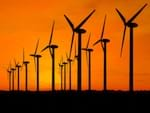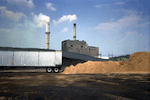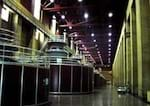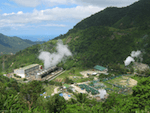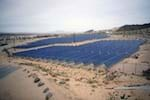This Living Lab offers you a chance to evaluate the renewable energy sources in the U.S. Renewable energy comes from natural resources such as wind, plant material, water (rain or tides), geothermal, or sunlight and is naturally replenished. Both renewable and non-renewable energy sources are used to generate electricity, power vehicles, and provide heating, cooling, and light. Renewable sources of energy vary widely in their cost-effectiveness and in their availability across the United States. Although water, wind, and other renewables may seem free, the cost comes in collecting and transporting the energy to the places where energy is needed. For example, to utilize energy from water, a dam must be built along with electric generators and transmission lines. Enter the Living Lab to look at the available renewable energy sources.
Wind
Wind is kinetic energy - a mass of air moving with speed (or velocity). The sun unevenly heats the Earth’s surface throughout the day. The air above the land heats up more quickly than the air over the water. The warm air expands and rises, and the cooler air rushes in to take its place, creating wind. This wind energy (or power) is harnessed using wind turbines. The wind rotates the turbine blades and turns a generator to produce electricity.
Biomass
Biomass is potential energy found in living or recently living organisms (plants, animals, and their waste products). The energy in biomass is stored from the sun through photosynthesis. We have been using biomass as energy since man began burning wood to cook and keep warm. Wood is the largest biomass energy resource today, but food crops, grassy and woody plants, residues from agriculture or forestry, oil-rich algae, and the organic component of municipal and industrial wastes. Even the fumes from landfills (which are methane, a natural gas) can be used as a biomass energy source.
Hydro
Flowing water creates energy called hydroelectric power or hydropower. Water constantly moves through a vast global cycle, evaporating from lakes and oceans, forming clouds, precipitating as rain or snow, then flowing back down to the ocean. The energy of this water cycle, which is driven by the sun, can be tapped to produce electricity. Hydropower uses a fuel—water—that is not reduced or used up in the process. The amount of available energy in moving water is determined by its flow (kinetic energy) or fall (potential energy). Swiftly flowing water in a big river carries a great deal of energy in its flow. Water descending rapidly from a very high point also has lots of energy in its flow. In either instance, the water flows through a pipe, or penstock, then pushes against and turns blades in a turbine to spin a generator to produce electricity. In a run-of-the-river system, the force of the current applies the needed pressure, while in a storage system, water is accumulated in reservoirs created by dams, then released as needed to generate electricity.
Geothermal
Geothermal energy is heat energy from the Earth’s core. Rock and underground water absorb this energy and become very hot. Electricity can be generated from this heat energy by drilling deep wells and pumping out the heated underground water. This water is so hot it turns to steam when it reaches the surface of the Earth, like at Yellowstone National Park in Wyoming, where this heat energy comes very close to the surface and creates geysers of hot water and steam.
Solar
Solar power captures and converts the sun’s radiant energy into energy that can be used to power homes and industry. Solar energy is responsible for heating the Earth’s atmosphere, driving the climate, and providing the foundation of most food chains through photosynthesis. Solar power can be collected using very large mirrors to concentrate sunlight onto receivers that collect the solar energy and convert it to heat. Solar power can also be collected using solar cells to convert sunlight directly into electricity. You have probably seen these cells as panels on the rooftops of houses or other buildings.





